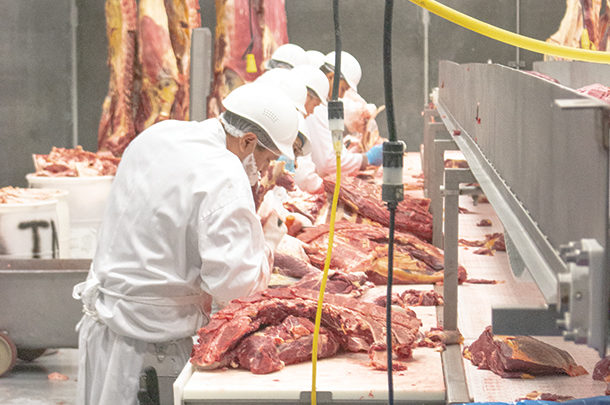The country’s livestock industry has been far from immune to the disruption; producers are facing, and will yet face, challenges due to declining food service demand, lower packing plant utilization, changing feedstuff demand and backlogs of livestock both in and outside finishing operations.
Declining food service demand for meat products due to quarantine restrictions was the first shock to the livestock industry. As restaurants around the country shifted to online ordering, drive-thru service or closing their doors entirely, food service declined rapidly. This sector accounted for nearly 60% of the nation’s job losses during March and April.
Despite many states reopening non-essential businesses, the near future of the food service industry remains unclear. Livestock producers rely on food service meat consumption to utilize products that are generally not “retail ready.” With restaurants purchasing fewer meat products than any time in recent memory, livestock futures lost nearly 30% of contract value within a few weeks.
Livestock futures contracts lost value, largely reflecting declining food service demand and positive COVID-19 cases starting to cluster in counties where meat packing plants were present. Amid these reports, numerous cattle and hog processing plants began to shut down indefinitely, temporarily or slow down chain speeds to decrease worker proximity in order to be CDC-compliant.
In an effort to reduce the disruption of packing plant closures and to ensure packing plants would not be liable for workplace negligence after CDC guideline adoption, the president issued an executive order mandating packing plants as essential infrastructure. These decisions created a situation of increasing market-ready animals coupled with an increasing demand for retail meat products. These situations put further downward pressure on livestock prices, both cash and futures. Retailers responded to the potential threat of retail meat shortage by pre-buying product. This, coupled with surging retail demand, caused boxed beef prices to rise nearly 50% within a month.
This situation created a ballooning margin (difference in price between boxed beef price and fed livestock cash price) for packing plants. Large margins caused local livestock organizations to propose unprecedented political and industry intervention. Two proposals that gained significant ground were the “set-aside” program by CattleFax, modeled after the Canadian program, and political bills to require packers to secure 50% of livestock through the spot/cash market. Both looked to potentially help alleviate short-term issues with cattle supply in exchange for market distortion, planned production and government intervention.
A coinciding effect of packing plant closures was the backup of livestock along the supply chain. Since production decisions about future supply were made months, in some cases years, prior to COVID-19, the backup at the packing plant did not allow market-ready livestock to be harvested and, subsequently, livestock were not able to enter finishing facilities.
This created an incentive for producers to euthanize livestock or dump products in order to reduce the oversupply of product. This was met with several conflicting issues, such as the ability to secure enough carbon for composting livestock and deciding who would compensate producers for added feeding, handling and disposal costs. It is still uncertain who, if anyone, will bear the additional cost burden due to euthanasia or proposed industry programs.
As livestock prices dropped and concern over how the quarantine would impact the demand for meat products, several studies tried to estimate the economic impact on the livestock industry. Impact to the cattle industry was estimated to be approximately $13 billion and $2.1 billion to the hog industry. Government issued several stimulus packages to try and compensate producers for these losses. The first stimulus package, CARES, appropriated $16.5 billion to be distributed among agriculture products. This appropriation fell well short of the total impact on the livestock sector.
Several months later, in an effort to more fully compensate producers, the HEROES act was also discussed, which aims to provide additional relief. The bill looks to have producers reimbursed 85% of losses determined by the secretary of agriculture and 10% less for each subsequent 30-day period. While it is impossible to fully estimate the impact of COVID-19 on the livestock industry, both stimulus packages provided can and will provide some payment relief to producers.
Input and feed costs were likewise volatile during the demand and supply issues that directly faced the livestock industry. Although grain stocks in the U.S. were down from a year ago on average over the last several months, automobile travel was greatly reduced (gasoline demand dropped 32% from the year-ago period in April), and oil prices were in a relative free-fall. Combined, this caused already-struggling ethanol plants to idle, reducing weekly ethanol production to fall to its lowest levels in over 10 years.
The supplies of distillers grains, a co-product of ethanol production, drastically decreased, leaving many livestock producers with reduced access to an important component of feed rations. Even in areas where distillers grains were still in production, their reduced availability put upward pressure on co-product prices while corn prices continued to fall. This, coupled with fewer processors to sell to and less available, more expensive distillers grains in the region, had many producers slowing down weight gain and substituting for relatively cheap corn and other feedstuff. This upward trend in price pressure partially contributed to the decrease in cattle-on-feed placements during March and April. The combined result was an additional strain on the ethanol industry and a less-than-ideal feeding situation for livestock producers.
In summary, the COVID-19 situation has been, and will continue to be, a situation unlike any the livestock industry has faced. While there is still much uncertainty, it’s reasonable to assume a slow uptick in food service demand, processing plant openings and fuel demand. One lesson our industry has painfully learned over the past year or so through the Holcomb fire and now COVID-19 is the urgent need to aggressively and actively manage price risk in all parts of the production process – both the actual price level and price variation. ![]()
PHOTO: As livestock prices dropped and concern over how the quarantine would impact the demand for meat products, several studies tried to estimate the economic impact on the livestock industry. Impact to the cattle industry was estimated to be approximately $13 billion and $2.1 billion to the hog industry. Staff photo.
Daniel Gertner is a graduate student with the department of agricultural economics, University of Nebraska – Lincoln.

-
Elliott Dennis
- Assistant Professor, Livestock Marketing Economist
- Department of Agricultural Economics, University of Nebraska – Lincoln
- Email Elliott Dennis








